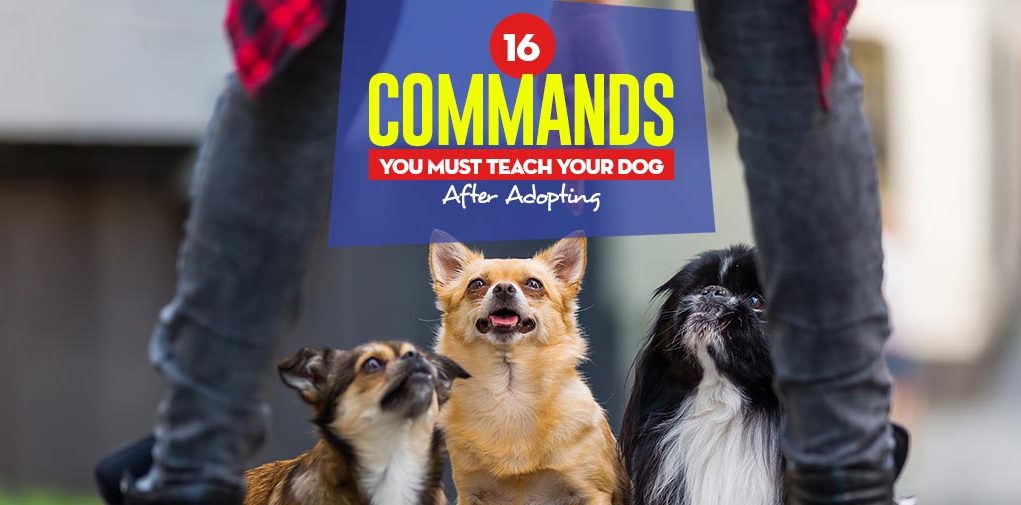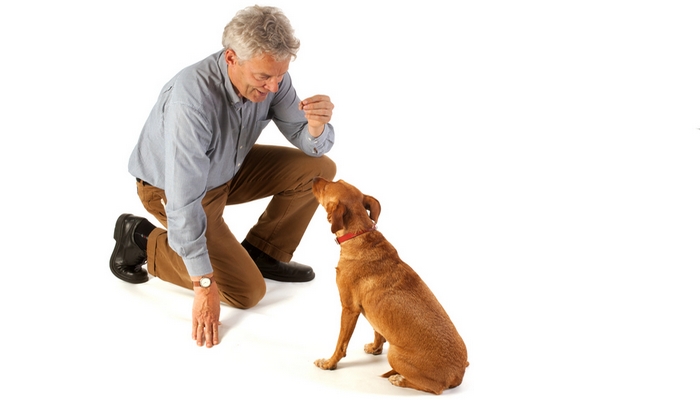You’ve made an excellent decision to adopt a homeless dog from your local animal shelter. However, when adopting a dog with an unknown history, it can be very difficult to know how much dog training the pet has received in the past. Therefore, it’s really important to establish the necessary “ground rules” right from the start of your relationship with your new companion.
A happy, well adjusted dog knows his role within your family; as a loyal protector, companion and friend. In this article, I've selected a range of excellent and most vital dog training commands you should teach your newly adopted dog – from basic to advanced – that will help your pet become a well behaved member of the family.
Remember, the key to successful training is consistency, praise and patience.
Also, another essential tip from dog trainers: keep all of your pet training sessions short (10-15 mins) and always end on a positive note. This ensures that your new dog remains happy and confident, ready for the next one. And don't forget to have fun!
ALSO READ: 25 Most Difficult Tricks and Commands to Train Dogs
16 Commands You Must Teach Your Dog After You've Just Adopted Them
Basic Dog Training 101
The following 5 commands create a solid foundation for success. When your dog can understand and listen to these commands consistently, you’ll know it’s time to challenge him and move on to the Intermediate level.
1. Sit
This is one of the most fundamental commands your dog should learn. Teaching him to sit properly, and on cue, will help you control his behavior in countless situations. For instance, when you’re trying to put his leash on for a walk but he’s running around excitably, a simple “sit” command will allow you to calmly and safely attach the leash.
2. Stay
This command is really useful in situations where you cannot be beside your dog but you need him to stay out of the way. For example, it's very useful when the doorbell rings and your are greeting guests.
The standard method is to first use “sit” then “stay” to tell your dog he should not move from that spot until you “release him” from the command. This is done vocally by saying “Ok” or with a combination of words and hand signals, like many other dog commands.
3. Down
This command is usually part of a combination with “sit” and “stay”, and used to keep your dog in a calm, relaxed position for a longer amount of time. It’s very useful when you have company or maintenance workers at your house, or if you’re out somewhere with your dog and need him to settle down.
4. Come
Teaching your new rescue dog to come back when called, otherwise known as “recall” is an integral part of his good behavior education. This command is useful when he’s playing in safe off-leash areas, and you can also potentially avoid dangerous situations or encounters when he’s off leash and might go after something he shouldn’t.
5. Heel
Teaching your dog to “heel” means showing him how to walk beside you properly on the leash without pulling you everywhere. Walk time is always an exciting part of your dog’s day, but he needs to learn his manners so that you both can enjoy the experience and adventure.
GUIDE: How To Train Your Dog Basic Commands
Intermediate Level Dog Training
Once your dog has mastered the basics, these next commands are important to maintain good behavior in a variety of situations as well as learning some fun ways to play together.
6. Off
This command is mostly directed towards exuberant dogs who tend to jump up on their owners or other people, particularly when greeting them.
It’s heartwarming when our pets are excited to see us, but a dog (especially a large dog) who jumps up on people is not acceptable and can even lead to injuries. Once he’s learned this command, he should immediately fall back on cue whenever he attempts to jump up on a person.
7. Leave It (or Drop it)
Sometimes people use the word “off” for this same command, but we wanted to specify this verbal cue to your pet’s toys or when he’s grabbed something with his mouth that he should not have (like garbage on the street, etc.).
A dog who properly responds to this command should loosen his grip on the object and allow you to take it from his mouth.
8. Fetch
Teaching your dog this command uses both “Come” and “Leave it” as additional cues. Fetch is a perfect game which gives your dog the exercise he needs and can be fun for everyone involved.
When you throw the item for your pet (ball, stick, etc..) he should grab it, return to you and allow you to take it back so you can throw it again. You can start in a smaller indoor space and work your way towards playing in the park or on the beach.
9. Place (or “to Bed”)
The long-form of this command is “Go to your Place” or bed, whichever word you prefer. Keep in mind to use the same word consistently, for the most effective training. At it’s peak effectiveness, this command can be used anywhere you happen to be visiting with your pet.
You can create a space that he knows is his “bed”, like a towel or blanket on the ground, in your office or the floor in a friend’s house. It’s a place your dog knows he can relax and rest while you work or enjoy time with friends.
10. Settle
Teaching your dog to settle down can be used as a precursor to “sit/down” or “go to your place”. This command involves using a combination of vocal and hand cues to “hush” your dog into a more relaxed state when he is over-excited so that he’s more apt to listen to further commands.
Essentially you’re teaching your dog to stay calm in situations where he might become anxious (like during a thunderstorm) or overstimulated (in a large crowd of people).
RELATED: The Ultimate Guide to Hunting Dog Training
Advanced Commands and Tricks
By now, your dog should be ready to learn some fun tricks and commands that will take him to a higher level of obedience!
11. Sit/Stay at a Distance
This fancy move requires your dog to understand both the vocal and hand signals for the “sit” and “stay” commands. It’s very useful when you need to be able to control your dog’s actions while he’s far away from you, like at the park or in the yard.
The idea is to call out to your dog, and once you have his attention, you’ll both speak and gesture the actions for him to follow. Ideally he should stay until you approach and can put the leash on him and further control the situation.
12. Speak/Quiet
Nobody wants a dog who barks all the time, yet it’s equally as important to have a loyal protector who can warn us of potential danger. By teaching your dog when it’s okay to “speak”, you also enable him to learn when he should stop and be “quiet”.
He won’t learn this overnight, but through consistency and praise you’ll soon have a dog who will give warning barks and listens when you say “quiet”. This can be a complicated set of commands to teach, especially to a dog who is already a continuous barker. Here’s a great reference on teaching your dog these commands.
13. Balancing Treats on His Nose
Once you’ve established a good relationship with your new dog, you can try some fancier moves like balancing treats (and other items) on his nose.
This is also a great exercise in impulse control for your dog, and can lead to many other opportunities for him to learn more intricate moves.
14. Shake Paw
Teaching your dog how to shake a paw is not only fun, but also helps to build more trust between you both because he will understand that it’s okay for his legs and feet to be handled.
Some dogs even naturally raise their paws when offered treats, which makes teaching this trick much easier.
15. Show Belly
Here’s another trick that is both fun and adds trust to your relationship with your new dog. Dogs will typically roll on their backs to show submission to other dogs they meet, but they can also be protective of that area since it is one of the most vulnerable on their bodies.
By showing your dog that it’s okay to expose his belly to you (and receive belly rubs!) you’re letting him know that you can be trusted. This trick begins with your dog in a down/stay position, and once mastered, it’s a small step to teach them how to “roll over”.
16. Roll Over
This trick is a classic, and fun for you and your dog to learn together. Here’s a quick step-by-step video and written guide on how to teach dog to roll over, and if your dog has already mastered the basics he should learn this trick pretty quickly.
You can also elevate this trick by teaching your dog specific hand signals for the command, so you can ask him to roll over from a distance.
READ NEXT: 10 Psychological Dog Training Tricks














